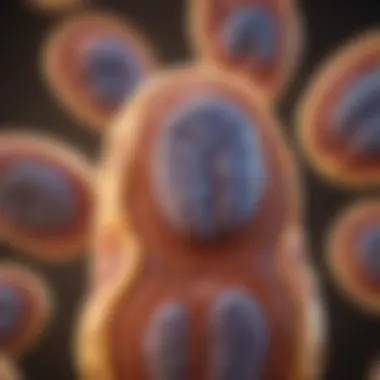Exploring POLG Mutation Symptoms and Impacts


Intro
Exploring the implications of POLG mutations is critical for understanding a variety of health challenges that can arise due to mitochondrial dysfunction. These disruptions affect mitochondrial DNA polymerase gamma, which plays a vital role in the replication and maintenance of mitochondrial DNA. When this polymerase is compromised, it not only affects energy production in cells but also leads to a range of symptoms across different bodily systems.
Recognizing the diverse manifestations associated with POLG mutations, it becomes clear that patients may present with neurological deficits, muscle weakness, and various metabolic disturbances. The complexity of these symptoms can challenge both patients and healthcare providers, making it crucial for research and clinical practice to emphasize this genetic condition and its clinical presentations.
In this article, we will unpack the symptoms linked to POLG mutations, analyze the mechanisms by which these mutations exert their effects, and explore diagnostic and treatment options available for those affected. Through a detailed examination of this genetic landscape, we aim to provide readers—ranging from students to seasoned researchers and healthcare professionals—with a thorough grounding in the subject.
Overview of POLG Mutations
The understanding of POLG mutations is fundamental for appreciating how they affect mitochondrial function. Mitochondrial DNA polymerase gamma, which is encoded by the POLG gene, plays a crucial role in maintaining mitochondrial DNA integrity and replication. When mutations occur in this gene, they can precipitate a cascade of symptoms that adversely impact cellular energy production.
This section will explore the importance of outlining the nuances of POLG mutations. Recognizing these insights can lead to early diagnosis, improved management strategies, and informed genetic counseling. A thorough grasp of the topic equips healthcare professionals and researchers with the tools to further innovate in treatment methodology and understanding of the pathophysiological effects.
Prolusion to POLG
POLG, or polymerase gamma, is essential in the replication and repair of mitochondrial DNA. Mitochondria serve as the energy powerhouses of cells, thus any disruption in POLG function can result in serious metabolic dysfunctions. Patients with POLG mutations often experience a myriad of symptoms that can affect multiple organ systems. This multifaceted impact makes POLG an important subject for both clinical practice and research.
Genetics of POLG Mutations
The POLG gene is located on chromosome 15. Mutations in this gene can be inherited in both autosomal recessive and dominant patterns. Severe mutations may lead to a complete loss of function, leading to conditions characterized by mitochondrial disorders. Each specific mutation can lead to a distinct clinical phenotype, which complicates diagnosis. Genetic testing plays a pivotal role in identifying these mutations, allowing for more targeted approaches to treatment and management.
Epidemiology and Prevalence
The prevalence of POLG mutations varies globally, with certain populations showing higher rates. It is estimated that the carrier frequency of POLG mutations ranges from 1 in 300 to 1 in 500 people. Mitochondrial diseases linked to POLG have diverse clinical manifestations and can emerge in childhood or adulthood. Given the often vague symptoms, underdiagnosis is common, which impacts understanding both the epidemiology and the burden of these mutations on public health.
“Understanding the epidemiology of POLG mutations is critical not only for medical professionals but also for public health awareness.”
Clinical Presentation of POLG Mutations
Clinical presentation in regards to POLG mutations is fundamental. Understanding the symptoms is crucial for diagnosis and management. Ignoring these symptoms can lead to misdiagnosis, thereby delaying appropriate care and treatment. Therefore, this section explores the most prominent symptoms such as neurological, muscular, and metabolic manifestations.
Neurological Symptoms
Neurological symptoms play a critical role in POLG mutations, profoundly impacting the quality of life of affected individuals. Key symptoms include seizures, ataxia, and peripheral neuropathy. Each of these symptoms highlights distinct aspects of the condition, offering insights into its complexity.
Seizures
Seizures are common in patients with POLG mutations. These episodes can vary in type and severity, resulting in significant neurological impairment. One key characteristic of seizures linked to POLG mutations is their unpredictable nature. Patients may experience various types, including focal and generalized seizures. The unpredictability contributes to immense challenges for both patients and caregivers.
Another unique feature is timing; seizures may occur at any age, presenting as the initial symptom in some cases. While seizures highlight the neurological impact of POLG mutations, they also serve as an essential clinical marker for diagnosis. Yet, they can complicate management, often necessitating long-term antiepileptic drug therapy.
Ataxia
Ataxia results in impaired coordination and balance, making daily activities challenging. This symptom emerges due to the involvement of the cerebellum, where the movements are regulated. Its presence is strikingly notable in POLG mutations. The key feature of ataxia is instability while walking, which can lead to falls and injuries. This aspect emphasizes the need for careful monitoring.
Ataxia might manifest in childhood or adulthood, adding to its significance in identifying POLG-related disorders. The unique nature of this symptom also means it may overlap with other conditions, complicating a clear diagnosis. Understanding its implications is crucial for both supportive care and therapy considerations.
Peripheral Neuropathy
Peripheral neuropathy presents as numbness, tingling, and weakness in extremities. It is a direct consequence of nerve damage, rendering this symptom essential for diagnosing POLG mutations. The distinguishing aspect is that symptoms can progress in varying degrees, which may be misinterpreted sometimes.
Patients may experience severe discomfort, impacting daily life. A unique advantage of recognizing peripheral neuropathy lies in early intervention. Early treatment can significantly improve motor function and reduce pain. On the other hand, it may lead to long-term challenges if not managed effectively.
Muscular Symptoms


Muscular symptoms associated with POLG mutations require equal attention and analysis. The most common muscular manifestations are myopathy, muscle weakness, and fatigue. Understanding these symptoms is vital for a comprehensive evaluation of the disease.
Myopathy
Myopathy signifies a disease of muscle tissue and is a prominent symptom associated with POLG mutations. A key characteristic is muscle degeneration, leading to significant weakness. This can have a profound impact on mobility, necessitating mobility aids for some patients. The benefit of identifying myopathy early is that it can guide specific therapeutic approaches. However, its unique feature is that it can exist in various syndromes, complicating diagnosis.
Muscle Weakness
Muscle weakness is often reported in patients and presents itself variably. This symptom’s concept extends beyond mere fatigue; it includes reduced strength resulting from muscle dysfunction. One noteworthy feature is that this symptom can impact all voluntary muscle groups, affecting everyday tasks. Recognizing muscle weakness can guide therapeutic choices. Furthermore, understanding the degree of weakness can indicate the progression of the disease.
Fatigue
Fatigue is an overwhelming sense of tiredness that is often linked with daily activities. This symptom can severely hinder quality of life, frequently occurring alongside myopathy and muscle weakness. The key feature of fatigue in patients with POLG mutations is that it is both physical and mental. This dual aspect complicates treatment options, as interventions might need to address both domains.
The unique feature of fatigue is that it can vary widely among individuals. Some patients report extreme fatigue, while others may only experience mild symptoms. This variance underlines the necessity for personalized approaches to management and therapy.
Metabolic Symptoms
Metabolic symptoms associated with POLG mutations require thorough exploration. Symptoms can include diabetes, lactic acidosis, and failure to thrive. Recognizing these disorders is crucial for improving patient outcomes.
Diabetes
Diabetes presents as a critical metabolic issue in POLG mutation patients. The unique aspect of diabetes in this context is that it can be atypical, presenting at different ages and often with unusual symptoms. This variability can lead to misdiagnosis. Understanding diabetes in relation to POLG is important due to its implications for overall health management. Any early intervention could significantly improve metabolic control. However, managing diabetes can become complex when compounded by other symptoms of POLG mutations.
Lactic Acidosis
Lactic acidosis is a condition characterized by an excess of lactic acid in the body, leading to oppression of metabolic processes. The hallmark of this condition is its acute presentation, often requiring urgent medical attention. This feature is essential as it underscores the potential severity of metabolic disturbances in POLG patients.
Recognizing lactic acidosis promptly can improve clinical outcomes, emphasizing the need for immediate intervention. However, its complexity can sometimes result in a delayed diagnosis, further complicating patient care.
Failure to Thrive
Failure to thrive is a significant concern, particularly in children affected by POLG mutations. This term generally indicates inadequate growth and development, raising alarms for pediatric healthcare providers. The critical characteristics include poor weight gain and stunted growth, necessitating early nutritional interventions.
The unique feature of failure to thrive is that it can encompass multiple factors, including genetic and environmental. Understanding this symptom’s implications helps to target appropriate nutritional and medical support.
Accurate identification of these symptoms underscores the importance of clinical vigilance in managing POLG mutations. Monitoring and timely intervention can greatly influence patient outcomes, enhancing life quality across various age groups.
Age of Onset and Variation of Symptoms
Understanding the age of onset and how symptoms can vary is crucial for comprehending POLG mutations. Different age groups can display distict symptoms and severity. This variability can affect diagnosis, treatment, and management of the condition. Early recognition of symptoms is important for timely intervention. The clinical presentation in infants often differs significantly from that seen in adults. Implications for healthcare providers also require a careful approach when assessing patients across different age cohorts.
Infantile-Onset Symptoms
Symptoms of POLG mutations that appear in infants can have a profound impact on development. Some common infantile-onset symptoms include:
- Psychomotor delay: Infants may exhibit slower development in motor skills and cognitive function.
- Seizures: Frequent and varied seizures are a significant concern, leading to an urgent need for medical intervention.
- Hypotonia: Reduced muscle tone can result in weakness and difficulty with movement.
- Failure to thrive: Many infants with POLG mutations show poor growth and weight gain, indicating serious metabolic issues.
Earlier diagnosis in infants can enhance outcomes through better management strategies. Distinguishing these symptoms from other genetic conditions is essential but challenging for clinicians.
Adult-Onset Symptoms
In adults, POLG mutations may present differently. Key symptoms often include:
- Myopathy: Muscle-related symptoms like weak muscles and pain during exertion become more pronounced.
- Ataxia: Coordination problems may emerge, affecting balance and gait.
- Focal neuropathy: Adults may experience nerve-related symptoms localized to specific body parts.
- Fatigue: Chronic fatigue is common, significantly affecting daily functions and quality of life.


The age of onset in adulthood often complicates the diagnosis since symptoms can overlap with other conditions. Comprehensive clinical evaluation is needed to identify POLG mutations effectively.
Variable Expression of Symptoms
One of the striking features of POLG mutations is the variable expression of symptoms. Even within families sharing the same mutation, some individuals may manifest severe symptoms while others may be relatively unaffected. Factors influencing this variability can include:
- Genetic Background: Additional genetic variations can interact with POLG mutations, impacting symptom severity.
- Environmental Factors: Lifestyle and environmental stressors also play a role in how symptoms express themselves.
- Age at Diagnosis: Earlier interventions can alter the disease course, potentially leading to different outcomes.
Understanding these variations is key for personalized treatment plans. Healthcare providers must be attuned to the fact that even subtle changes in patient presentation can guide management strategies effectively.
"The variability in symptoms highlights the complex interplay of genetics and environment in POLG mutations."
In summary, recognizing the importance of the age of onset and the varying expression of symptoms can lead to more effective management and improved outcomes for those affected by POLG mutations.
Diagnostic Approaches
Evaluating POLG mutations requires a multi-faceted diagnostic strategy. Understanding how to correctly diagnose these mutations is imperative for both accurate identification and effective management of the associated symptoms. In this section, we will detail the key diagnostic tools and methods available, including clinical evaluations, genetic testing, and biochemical analyses. Each of these approaches contributes to painting a detailed picture of the patient's condition, aiding in the decision-making process for treatment.
Clinical Evaluation
Clinical evaluation is the first step in diagnosing POLG mutations. This process involves a thorough medical history and physical examination. Healthcare professionals gather information about the patient's neurological, muscular, and metabolic symptoms. They may ask about the patient's family history, as genetic conditions often run in families.
During this evaluative phase, clinicians look for specific clinical features that may suggest a POLG mutation. Examples include signs of ataxia, muscle weakness, or unexplained metabolic disturbances. Having a comprehensive clinical evaluation sets the foundation for further diagnostic exploration and guides the necessity for advanced testing.
Genetic Testing
Genetic testing is a cornerstone in confirming POLG mutations. This process involves analyzing a sample of the patient's DNA, typically extracted from blood or saliva. Genetic tests focus on identifying specific mutations within the POLG gene. These tests can reveal whether a patient is a carrier of a variant that may contribute to their symptoms.
There are two primary types of genetic testing:
- Single gene testing: This approach targets the POLG gene specifically.
- Next-generation sequencing: This method can identify mutations in multiple genes simultaneously, which is useful when a broader range of genetic disorders is suspected.
Obtaining a positive result from genetic testing can help clinicians make informed decisions regarding treatment and provide valuable information for family planning and genetic counseling.
Biochemical Analysis
Biochemical analysis complements genetic testing by examining the metabolic functions that may be affected by POLG mutations. This involves evaluating various biomarkers in the patient's blood or other bodily fluids. Common tests include assessing levels of lactate, pyruvate, and other metabolites that can indicate mitochondrial dysfunction.
By analyzing these biochemical markers, healthcare professionals can:
- Identify metabolic abnormalities that may not be evident through clinical evaluation alone.
- Monitor treatment efficacy over time when interventions are made.
- Help formulate a more tailored management plan based on the obtained data.
Management of POLG Mutations
Effective management of POLG mutations is crucial for optimizing patient outcomes and improving quality of life. These mutations, which affect the mitochondrial DNA polymerase gamma, can lead to a variety of symptoms. Addressing these symptoms adequately can significantly impact both patients and their families. Management strategies must be tailored to individual needs, considering the diverse expression of symptoms and their varying intensities.
A well-rounded approach is beneficial. It includes symptomatic treatments, participation in clinical trials, and providing genetic counseling. Each of these components plays a vital role in comprehensive care. The overall goal is to alleviate symptoms, reduce complications, and support patients in their daily lives.
Symptomatic Treatment
Symptomatic treatment focuses on managing the various clinical manifestations associated with POLG mutations. This can include medications, physical therapy, and other therapeutic interventions tailored to the specific symptoms a patient presents.
- Medications: For neurological symptoms, anticonvulsants may be prescribed to manage seizures. Pain management is also necessary for peripheral neuropathy, possibly incorporating analgesics and neuropathic medications.
- Physical Therapy: Rehabilitation through physical therapy can address muscular symptoms such as weakness and ataxia. Tailored exercise regimens help improve mobility, enhance strength, and maintain functionality.
- Nutritional Support: Metabolic issues can often benefit from dietary modifications. Consulting with a nutritionist may ensure adequate calorie intake and address specific deficiencies, such as those found in lactic acidosis.
Through these targeted strategies, symptomatic treatment aims to improve daily functioning and enhance the overall quality of life.


Clinical Trials and Research
Engagement in clinical trials is an essential aspect of experimental management for POLG mutations. As research into the underlying mechanisms of these mutations advances, so do potential novel therapies.
Participation in clinical trials offers several significant advantages:
- Access to Cutting-Edge Treatments: Patients may gain access to new therapies that have not yet become widely available. These treatments could be potentially more effective than standard care options.
- Contribution to Research: By participating, patients contribute valuable data. This data enhances the scientific community’s understanding of POLG mutations and leads to better treatment protocols for future patients.
- Monitoring and Support: Clinical trials often provide closer monitoring by healthcare professionals. This close involvement may lead to earlier detection of complications or disease progression.
Continued funding and investment in research are vital for developing new and effective treatments for patients affected by these mutations.
Genetic Counseling
Genetic counseling is a fundamental component of managing POLG mutations. This service provides patients and families with necessary information about the condition, inheritance patterns, and potential implications.
Key elements include:
- Understanding Risks: Families can learn about the risk of transmitting POLG mutations to future generations. Knowledge about genetic risks assists in familial decisions regarding health and future planning.
- Emotional Support: Receiving a genetic diagnosis can be overwhelming. Counseling can help patients and families cope with the emotional aspects, offering a supportive environment to discuss concerns.
- Guidance on Next Steps: Genetic counselors provide advice on screening for other family members. They can also guide patients in understanding available treatments and clinical trials.
Genetic counseling thus aids in navigating the complexities of POLG mutations, paving the way for informed decision-making and improved management.
Prognosis and Long-term Effects
Understanding the prognosis and long-term effects of POLG mutations is crucial for both patients and healthcare providers. This section aims to elucidate the variability in outcomes among different age groups and offers strategies for coping that can benefit both patients and their families. Recognizing potential trajectories can aid in a positive adaptation and management of the condition.
Outcomes in Different Age Groups
The outcomes associated with POLG mutations vary significantly across different age groups. In infants, the prognosis can often be poor due to severe early-onset symptoms such as mitochondrial myopathy and neurological decline. Those diagnosed at a young age may experience rapid progression of symptoms, leading to significant challenges in mobility and cognitive function.
In children and adolescents, symptoms may be more variable. Many may have a milder progression, allowing for better quality of life with appropriate management. However, some might still face developmental delays or neurodegenerative conditions. The variability in outcome is a reflection of the different types of POLG mutations and their expressions.
Adults often exhibit different manifestations of POLG mutations. Symptoms may range from mild to severe. Many adults may experience a gradual decline in energy levels and physical strength. Chronic fatigue and myopathies are common. Longitudinal studies have indicated that adult patients can manage their symptoms with ongoing medical care and lifestyle adjustments, contributing to improved life expectancy.
"The prognosis in POLG mutation cases is highly individualized, depending on genetic background, age of onset, and treatment approaches."
Coping Strategies for Patients and Families
Coping with the implications of POLG mutations can be a complex journey for both patients and their families. Some effective strategies include:
- Education: Understanding the condition helps in making informed decisions about management and treatment.
- Support Groups: Engaging with support networks can provide emotional relief and shared experiences.
- Multidisciplinary Care: Working with a team of healthcare providers, including neurologists, nutritionists, and genetic counselors, ensures comprehensive management.
- Physical Therapy: Tailored physical therapy programs can help in managing muscular symptoms, improving mobility and function.
- Mental Health Support: Access to mental health professionals helps address anxiety or depression that may arise due to health challenges.
These strategies can significantly impact the quality of life for patients. By being proactive in addressing both medical and emotional needs, families can work towards creating a supportive environment.
Emerging Research and Future Directions
The investigation into POLG mutations has yielded numerous insights, but much remains undiscovered. Emerging research in this domain not only broadens our understanding of these mutations but also highlights potential therapeutic pathways. It is imperative for researchers and healthcare professionals to stay abreast of these developments, as they could significantly impact patient care and treatment outcomes.
Innovative approaches are being explored that focus on both symptomatic management and the underlying causes of POLG-related disorders. This dual focus is critical because it underscores the complexity of the condition and the need for multifaceted treatment strategies. The benefits of this research include the possibility of improved patient quality of life, reduced symptoms, and perhaps potential disease modification.
Novel Therapies
Novel therapies are being developed to target the various symptoms of POLG mutations. These treatments aim to alleviate the range of neurological, muscular, and metabolic symptoms associated with these mutations. One area of focus is gene therapy, which seeks to correct the defective POLG gene. While still in early stages, preliminary results indicate promise. Some clinical trials are involving the use of small molecules that can enhance the function of existing mitochondrial pathways. This could potentially mitigate some of the dysfunction caused by POLG mutations.
Additionally, researchers are investigating compounds that have shown neuroprotective effects. For example, coenzyme Q10 and certain antioxidants are being examined for their role in supporting mitochondrial health. Clinical studies are necessary to determine their efficacy in patients who inherit POLG mutations.
Understanding Disease Mechanisms
Understanding the underlying mechanisms of POLG mutations is crucial for developing interventions. It involves exploring how these mutations impact mitochondrial function and the resultant clinical symptoms. Research is revealing that POLG mutations can disrupt mitochondrial DNA replication, leading to various forms of cellular stress. This stress triggers pathways that may result in cell death or dysfunction, ultimately manifesting as the symptoms observed in patients.
Moreover, the heterogeneity of POLG mutations complicates prediction of symptoms. Researchers are identifying specific mutations associated with particular clinical presentations, paving the way for personalized medicine. This will guide treatment decisions and improve prognostic assessments.
As the knowledge base grows, it becomes evident that a comprehensive understanding of disease mechanisms is essential for advancing therapy options. Continued research will help illuminate the complex relationships between genetic mutations, mitochondrial dysfunction, and resulting clinical outcomes.







